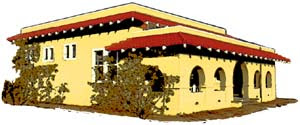Lake Tuendae at the Cal State University Desert Studies Center at Zzyzx.
Commentary by Linda Castro
SCVNews.com
The sign for exit 239 on Interstate 15, six miles southwest of Baker, says “Zzyzx Road.” Have you ever gotten off at that exit to explore? Have you wondered what is down that road?
First, you might be wondering how to pronounce this strange word. Zzyzx is pronounced “Zī – zĭx,” with the emphasis on the first syllable. Zzyzx is a made-up word.
The Zzyzx area has had human inhabitants since prehistoric times due to the spring (Soda Springs) and Soda Lake, now a dry lake bed. Projectile points and rock art have been found in the area.
The Mojave Road runs near Zzyzx. The road began as a trail used by Native Americans, Spanish missionaries, explorers and settlers in the 18th and 19th centuries. The land passed into U.S. hands in 1848, and in early 1858 what had become known as the Mohave Trail became the Mojave Road, a wagon road that connected with other significant trails such as the Santa Fe Trail.
In 1859, the Mojave Road came under the purview of the U.S. military. Army posts were established along the route to protect settlers and travelers from the attacks of the resident Paiute, Mojave and Chemehuevi peoples until 1871. This also opened the way for large mining development in the Mojave Desert region of San Bernardino County. The Tonopah and Tidewater Railroad, built in the early 1900s to carry ore from the California deserts to ports in the Los Angeles area, also had a station in the area named Soda Springs.
All of this history is similar to that of many other places in California’s desert. However, in 1944, this area was used for a rather unusual purpose: a health spa.
Curtis Howe Springer opened the Zzyzx Mineral Springs and Healing Center in 1944 at this location, which was federal land, after filing dubious mining claims for about 12,000 acres surrounding the springs. He gave the area the made-up name of Zzyzx, claiming it to be the last word in the English language.
Springer was a self-professed medical doctor and Methodist minister, but he did not hold a license to be either. He was a radio evangelist in Pennsylvania in the 1930s, and he used that platform to convince his faithful followers to move to Zzyzx so they could begin a utopian way of living with an abundance of miracle cures.
Once Springer decided upon the location of his utopian desert healing center, he began to recruit laborers to carry out his dream. He would drive a bus to Skid Row in Los Angeles to find recruits and promise them food and shelter in exchange for work. Some of the workers quit upon learning of the policy prohibiting alcohol, but many stayed for years.Springer promoted his healing center on his syndicated religious radio show and asked listeners for donations for his miracle cures. The miracle elixirs were marketed as the cure for everything from hemorrhoids to cancer. Springer’s most popular potion was one that he claimed cured baldness: Mo-Hair. After users rubbed Mo-Hair onto their scalps, they were instructed to bend over and hold their breath for as long as possible. When the blood rushed to their head from lack of oxygen, Springer would claim that their red faces proved his miracle potion was working.
For the next 30 years, hundreds of visitors came to Springer’s spa in search of a healthier lifestyle. But Springer’s scheming business practices would eventually catch up to him.
Springer attempted to sell land adjacent to Zzyzx, despite the fact he did not own the land. This, along with lawsuits brought against him by disgruntled users of Mo-Hair, eventually brought government attention to him and to Zzyzx. The Bureau of Land Management evicted Springer and his followers and reclaimed the land in 1974.
Since 1976, the BLM has allowed the California State University to operate its Desert Studies Center at the site of the old spa. A consortium of CSU campuses uses the area for their study of the desert. The buildings and pond developed by Springer are still there today.
Zzyzx is open to the public. Exit at Zzyzx Road and travel on the road for about five miles along the western shore of Soda Dry Lake until the road ends at a parking lot. You can stroll around Lake Tuendae and along the shore of Soda Dry Lake. If classes are in session, please be courteous and do not disturb participants.
Zzyzx is now also included in the Mojave National Preserve, established in 1994.
Zzyzx is a short detour off of Interstate 15 and is a quirky part of California’s desert history.




